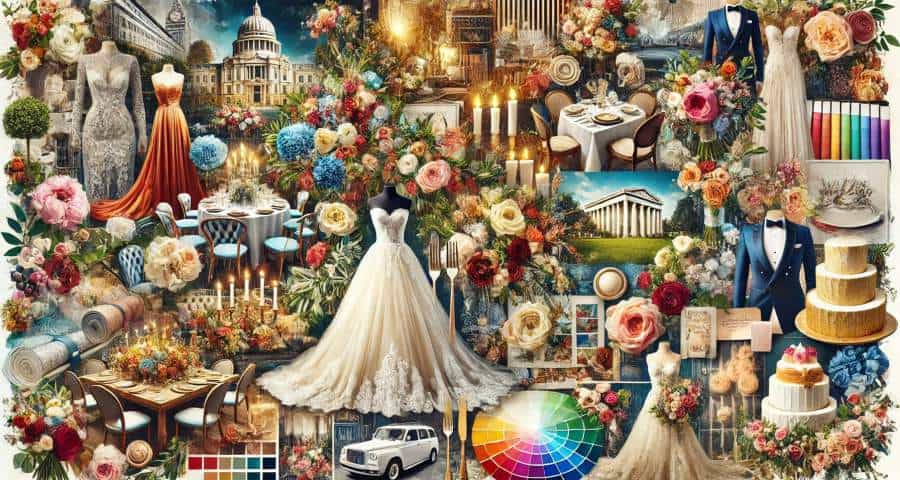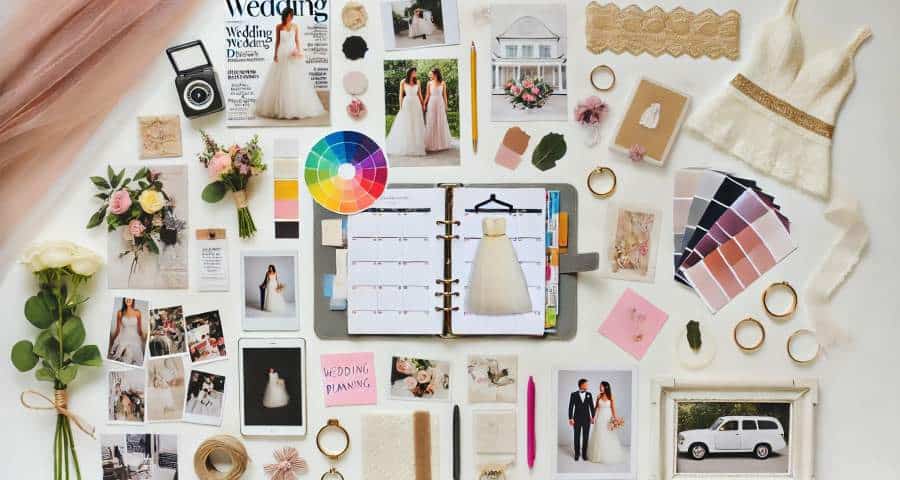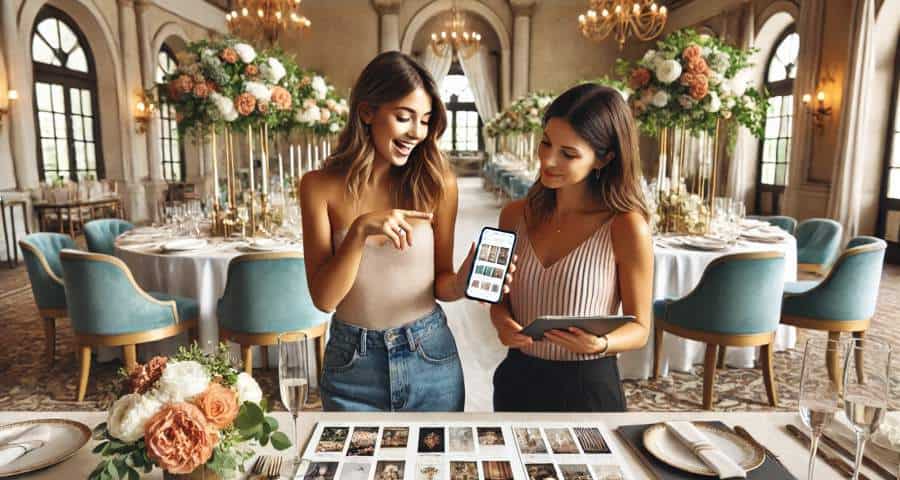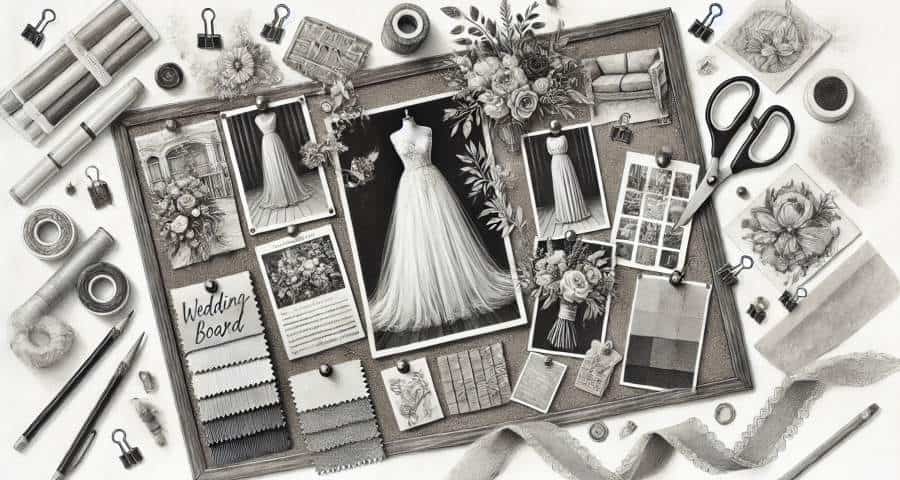A wedding vision board can help transform the complex process of planning your wedding into a more manageable and enjoyable journey.
It serves as a visual representation of your dreams and ideas, helping you visualise your perfect day with clearer focus.
A vision board is not just collecting pretty pictures, but creating a powerful tool that aligns every choice and detail with the overall vision you’ve set for your wedding.
What is a Wedding Vision Board

A wedding vision board is a curated collection of images, colours, textures, and words that represent the style, mood, and overall aesthetic you want for your wedding day. It’s a visual tool that helps you articulate and refine your wedding vision, serving as a central reference point throughout your planning process.
It allows you to see the potential look and feel of your wedding. It helps in piecing together various elements, giving you a clear picture of how different aspects like colour schemes, lighting, and floral designs will interact with each other on your wedding day.
This is because it helps maintain a consistent style and theme. It ensures that all elements of your wedding complement each other, creating a seamless and cohesive aesthetic. This coherence is crucial not only for the visual appeal but also for creating a memorable experience for you and your guests.
It can also be an effective communication tool, providing a clear and visual explanation of your desires and expectations. It can help vendors and service providers understand your style and work more efficiently to bring your vision to life.
How to create your Vision Board

The process of creating your wedding vision board involves several key steps.
Step 1: Choosing Your Vision Board Format
The first step in creating your wedding vision board is deciding whether it will be physical or digital. This choice will influence how you collect, organise, and use your vision board throughout the planning process.
Physical Vision Boards A physical vision board is a tangible collection of images, fabric swatches, colour palettes, and other elements arranged on a cork board, poster board, or in a scrapbook.
Pros:
- Tactile experience that can feel more engaging and creative
- Easily displayable in your home or planning space
- Can include physical samples like fabric swatches or paper textures
Cons:
- Less easy to modify or update
- Can be bulky to transport or share with vendors
- Limited to physical materials you can collect or print
Digital Vision Boards: Digital vision boards are created using online tools like Pinterest, Canva, or specialised wedding planning apps.
Pros:
- Easy to update and modify as your vision evolves
- Simple to share with partners, family, and vendors
- Access to a vast array of online images and resources
- Can be accessed from anywhere via smartphone or computer
Cons:
- Lacks the tactile element of a physical board
- Might be overwhelming due to the sheer volume of available content online
- Requires basic digital skills and reliable internet access
Your choice between physical and digital will depend on your personal preferences, tech-savviness, and how you plan to use your vision board.
Some couples even opt for a hybrid approach, creating a digital board for easy sharing and a physical board for tangible inspiration.
Remember, there’s no right or wrong choice, the best format is the one that feels most inspiring and useful to you in your wedding planning journey.
Step 2: Gathering Inspiration
The items you choose for your vision board should represent the overall feel, look, and mood you desire for your wedding. These elements can range from photographs and colour swatches to fabric samples and quotes. Here’s what to consider when selecting these items:
- Visual Appeal: Choose images that strike you visually. Look for photos of wedding setups, floral arrangements, or even fashion and art that aligns with the style you envision for your wedding.
- Colour Scheme: Ensure that the images reflect your desired colour palette. This can include paint chips from a hardware store, fabric swatches, or pictures with dominant colours that match your theme.
- Emotional Resonance: Select items that evoke the emotions you want to feel on your wedding day. Consider including a photo of a breathtaking sunset at your ideal venue or a quote about love and partnership that resonates with you.
- Texture and Fabric: For a physical board, add samples of lace, silk, or other fabrics you’re considering for dresses or decor. These textures help you visualise the tactile aspects of your big day.
- Inspirational Quotes: Incorporate quotes or phrases that inspire you and keep your focus on what truly matters about your wedding—the celebration of love and commitment.
Sources for Material:
- Magazines and Catalogues: Flip through bridal, fashion, and lifestyle magazines for high-quality visuals and inspiration. Vendor catalogues can also offer a wealth of ideas.
- Online Platforms: Websites like Pinterest, Instagram, and wedding blogs are treasure troves of inspiration. Use them to find and save images that align with your vision.
- Real-World Inspiration: Don’t overlook the inspiration that surrounds you every day—nature, architecture, fashion, and even interior design can provide unique ideas that can be incorporated into your wedding theme.
- Craft and Fabric Stores: Visit these stores to collect physical samples like fabrics, papers, and decorative elements that might be useful for your board.
Step 3: Organising and Assembling Your Vision Board
Begin by deciding on the layout of your vision board. You may choose to organise it by different wedding elements such as attire, decorations, floral arrangements, and venue, or by the mood and colour scheme. This initial decision will dictate how you will place each item on your board.
- Categorization: Divide your board into sections based on categories that are most relevant to your wedding planning. Common categories include:
- Attire: Dresses, suits, accessories.
- Colour Palette: Swatches and images that define your wedding’s colour theme.
- Mood and Atmosphere: Pictures that evoke the desired feel of your wedding, such as cosy, romantic, or festive.
- Vendors and Inspirations: Sections for catering ideas, photography styles, and décor inspirations.
- Visual Harmony and Balance: Arrange your items in a way that creates visual harmony and ensures balance. Avoid letting any single element overwhelm others, which might skew the perception of your wedding’s overall theme. Try to distribute colours and textures evenly to give each element equal visual weight.
- Flexibility for Changes: Opt for methods that allow for easy adjustments. For physical boards, use pins or small clips instead of permanent adhesives, enabling you to move items around as your ideas evolve. For digital boards, make use of layers and folders in digital design tools to manage and modify elements effortlessly.
- Multiple Boards Option: If you find yourself with many ideas or if you’re considering different themes, think about creating multiple vision boards. This can help you explore various options without the constraint of a single board. Each board can represent a different aspect or theme of your wedding, allowing for a more extensive exploration of possibilities.
- Regular Reviews and Updates: As your wedding planning progresses, regularly review and update your vision board(s). Remove items that no longer fit, add new inspiration, and adjust layouts to reflect your refined vision. This ensures that your vision board remains a dynamic and inspiring guide throughout the planning process.
What goes on to your vision board?

Your vision board is a personal reflection of your unique wedding dreams. While you don’t need to include every element listed below, consider these key items to focus on what matters most to you and your partner:
- Images of Venues and Locations: Photos of potential venues or locations where you’d like to hold your wedding. These images set the foundation for the style and scale of the event.
- Wedding Attire Inspiration: Pictures of wedding dresses, suits, and other attire for you and your bridal party. This also includes accessories like shoes, jewellery, and other special touches.
- Colour Palettes and Fabric Swatches: Colour schemes that you love and actual fabric swatches that you might use for dresses, tablecloths, or other decor. This helps in visualising the overall aesthetic and ensuring colour harmony.
- Floral Arrangements and Bouquets: Images of floral designs, bouquets, and other botanical decorations that inspire you. Flowers play a crucial role in adding life and colour to your wedding.
- Catering and Cake Ideas: Pictures of potential dishes, cakes, and other culinary delights. Food is a major part of the wedding experience, and visualising it can help you decide what fits your theme and guest preferences.
- Decor and Styling Ideas: Photos and items that represent the style of decor you are considering, from lighting fixtures to table settings and signage.
- Quotes and Words of Inspiration: Sentences or words that resonate with your vision of marriage or that capture the essence of the relationship you’re celebrating. These can be motivational, romantic, or humorous.
- Entertainment and Layout Ideas: Visuals or notes about types of entertainment you’re considering. Also, sketches or layouts of seating arrangements and venue setups can be included to visualise guest experiences.
- Personal Photos or Mementos: Incorporating personal elements can make your board unique and deeply meaningful. This might include photos of you and your partner, images from movies or books you both love, or snapshots from memorable dates.
- Stationery and Invitation Designs: Examples of invitation styles, save-the-dates, or other paper goods that set the tone for your wedding.
- Photography and Videography Styles: Sample images or clips that represent the style of photography or videography you prefer for capturing your day.
- Transportation Ideas: If relevant, images of wedding cars or other transportation methods you’re considering.
- Seasonal Elements: If you’re planning a seasonal wedding, you might include images that represent that season’s characteristics.
- Cultural or Religious Symbols: For couples incorporating specific cultural or religious elements, visual representations of these could be important.
Tips for Using Your Vision Board Effectively

An effective vision board is a dynamic tool in wedding planning. It acts as a visual summary of what you and your partner envision for your special day, serving as a roadmap for vendors and a touchstone for your planning decisions. By keeping it cohesive, practical, collaborative, and communicative, your vision board will be an invaluable asset in bringing your wedding dreams to life.
- Maintain Cohesion While Embracing Diversity: Your vision board should be a harmonious blend of diverse ideas that align under a unified theme. This balance ensures that your wedding feels cohesive, even with varied inspirations.
- Mix and Match: Integrate different elements that reflect both your tastes, but adhere to a consistent colour scheme or style.
- Theme Consistency: Ensure that images and items complement each other, preventing any single idea from overwhelming the others.
- Balance Aspirational Ideas with Practical Considerations: Dream big, but keep your vision board grounded in reality. It’s crucial to strike a balance between high-end aspirations and practical possibilities.
- Budget Awareness: Include elements that fit within your budget, clearly identifying splurges versus essential items.
- Venue and Logistics: Take into account practical aspects such as venue size and guest comfort when selecting images and ideas for your board.
- Involve Your Partner in the Process: Building a vision board should be a joint effort. This ensures that the wedding reflects the tastes of both partners and enhances the overall planning experience.
- Shared Sessions: Dedicate time to collaboratively work on the vision board, discussing the significance and relevance of each item.
- Equal Representation: Ensure that preferences and ideas from both partners are equally represented on the board.
- Use Your Vision Board to Communicate with Vendors: A vision board is an excellent communication tool. It provides a clear representation of your ideas to vendors, helping them understand and deliver your vision accurately.
- Detailed Discussions: Take your vision board to meetings with vendors to vividly illustrate your ideas.
- Feedback Incorporation: Adapt and refine the board based on input from vendors, accommodating professional advice and logistical needs.
- Regular Reviews and Updates: As your wedding planning progresses, regularly review and update your vision board. This not only keeps your ideas fresh and aligned with your evolving plans but also helps in adapting to any new inspirations or changes in circumstance.
- Staying Focused and Motivated: Use your vision board as a source of motivation, especially during stressful times. When wedding planning feels overwhelming, revisit your board to remind yourself of the big picture and the reasons behind your choices. It can serve as a visual affirmation of your journey and help maintain your enthusiasm and focus.
Common Mistakes to Avoid

A wedding vision board is a dynamic tool that can effectively guide your wedding planning. However, several common mistakes can undermine its effectiveness. By recognizing these pitfalls, you can ensure that your vision board not only inspires but also practically guides you toward your dream wedding.
- Overloading Your Board: While it’s exciting to explore numerous ideas, overcrowding your vision board can lead to confusion and indecision.
- Keep It Simple: Concentrate on key elements that genuinely represent your wedding aspirations. Opt for quality and relevance over quantity.
- Regular Pruning: Routinely refine your board to remove outdated ideas or items that no longer align with your evolving vision.
- Neglecting Your Personal Style for Trends: It’s essential that your board reflects your personal style rather than just current trends.
- Stay True to Yourself: Prioritise personal preferences and values over fleeting trends.
- Blend Trends Thoughtfully: Integrate trends in a way that complements your unique style.
- Forgetting About Budget Considerations: Overlooking budgetary constraints can lead to unrealistic planning.
- Be Realistic: Incorporate affordable alternatives and clearly mark the costs of items to keep track of spending.
- Prioritise: Determine which elements are essential and worth the investment, helping to make informed compromises when necessary.
- Ignoring Practical Aspects: Aesthetics are important, but practical considerations are crucial for a feasible wedding plan.
- Venue Capacity and Logistics: Ensure your venue and design choices comfortably accommodate your guest count and event needs.
- Weather and Comfort: Plan for weather contingencies and guest comfort, especially for outdoor or seasonal weddings.
- Not Updating the Vision Board: Failing to revise your vision board can create a gap between your initial ideas and the actual wedding.
- Adapt to Changes: Update your board as plans develop and as new information becomes available.
- Lack of Balance Between Partners’ Visions: Ensure that the vision board represents both partners equally.
- Collaborative Effort: Regularly discuss and adjust the board together to reflect both partners’ dreams and ideas.
- Open Communication: Maintain clear and ongoing communication, especially if one partner is more involved in the creation process.
- Overlooking the Guest Experience: Your wedding should also consider the comfort and enjoyment of your guests.
- Think of the Attendees: Include elements on your board that enhance the guest experience, ensuring everyone has a memorable time.
- Inconsistency Across Elements: A cohesive theme or style is essential for a unified wedding experience.
- Unified Theme: Keep all elements like invitations, décor, and attire consistent with the overall style and palette of your wedding.
- Flexibility and Adaptability: It’s vital to remain flexible and open to changes as your wedding planning progresses.
- Embrace Flexibility: Be prepared to adapt your vision in response to logistical necessities, budget adjustments, or available options.
Using Your Vision Board Throughout the Planning Process

Your wedding vision board is a living document of your dream day. By referring to it regularly for decision-making, updating it as your plans solidify, and using it to communicate effectively with your partner and vendors, you can ensure that your wedding truly reflects your desires and remains a source of inspiration throughout the planning process.
- Referring to Your Board for Decision-Making: Your vision board serves as a visual reference that can simplify decision-making by keeping your preferences and overall wedding theme at the forefront. Use it to:
- Align Choices with Vision: Before making any major decisions, refer to your vision board to ensure choices align with the overall style and feel you desire.
- Resolve Discrepancies: When opinions differ, your vision board can act as a neutral ground to help find a middle path that respects both perspectives.
- Streamline Vendor Communications: Share your vision board with vendors to give them a clear understanding of what you’re looking for. This can be especially useful with florists, decorators, and caterers.
- Updating and Evolving Your Board as Plans Progress: As your wedding planning advances, your ideas and possibilities will evolve. It’s crucial to keep your vision board updated to reflect these changes:
- Incorporate Real Samples: As you finalise elements like invitations, fabric swatches, or floral samples, add these to your board to replace generic images.
- Adjust for Practicalities: Sometimes, what looks good in a picture may not be practical in reality. Update your board to reflect practical options that work better in your actual venue or situation.
- Reflect Budget Adjustments: If budget constraints require changes, update your board to include cost-effective alternatives that still capture the essence of your original vision.
- Regular Reviews with Your Partner: Make it a habit to review the vision board regularly with your partner. This not only ensures that you both remain aligned with the evolving plans but also helps keep the excitement alive:
- Scheduled Reviews: Set a regular schedule, perhaps once a month, to review and update the board together.
- Flexibility and Adaptability: Use these reviews as opportunities to discuss what’s working and what might need changing. Be open to each other’s inputs to ensure the board evolves in a way that reflects both of your visions.

